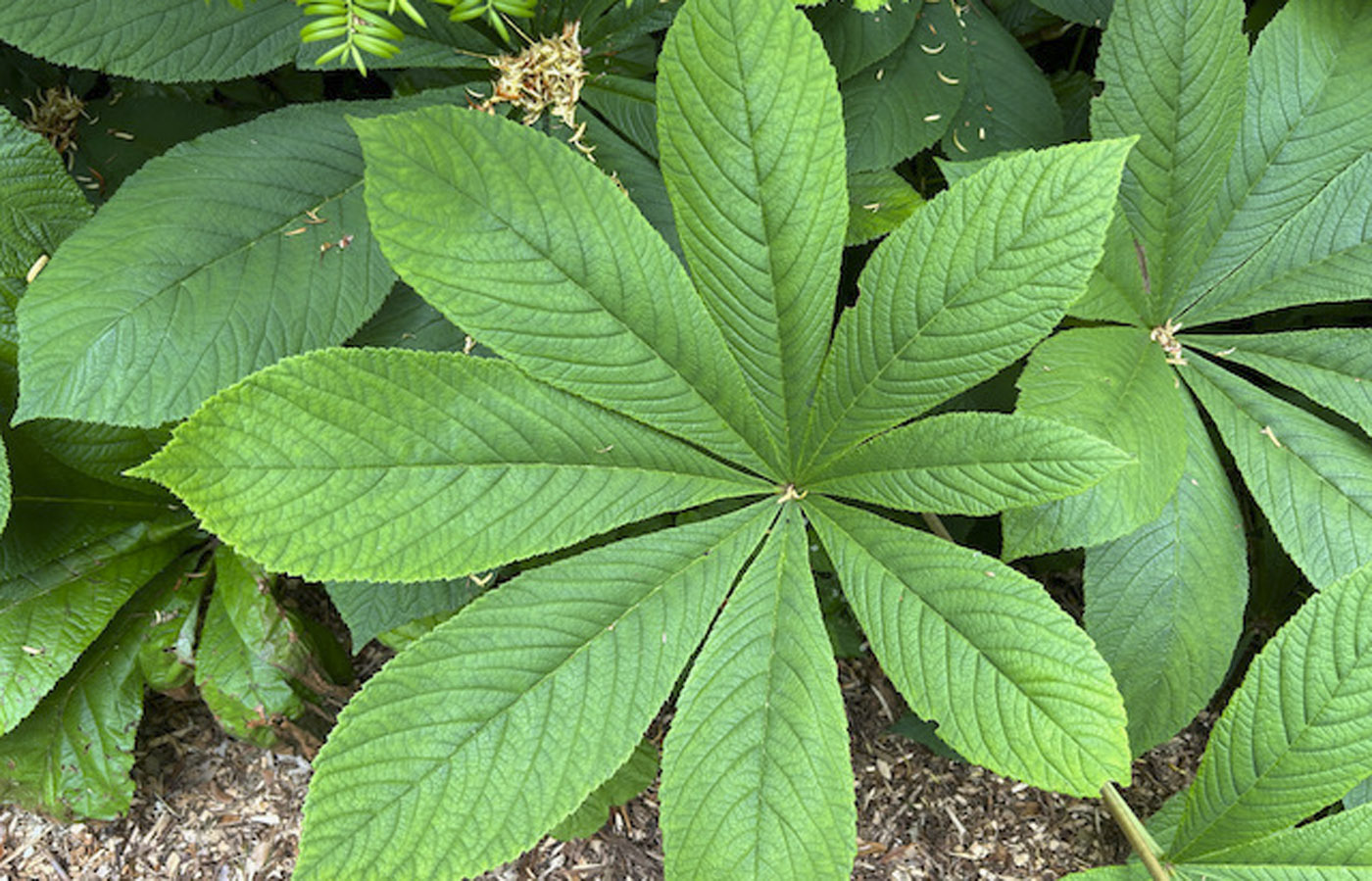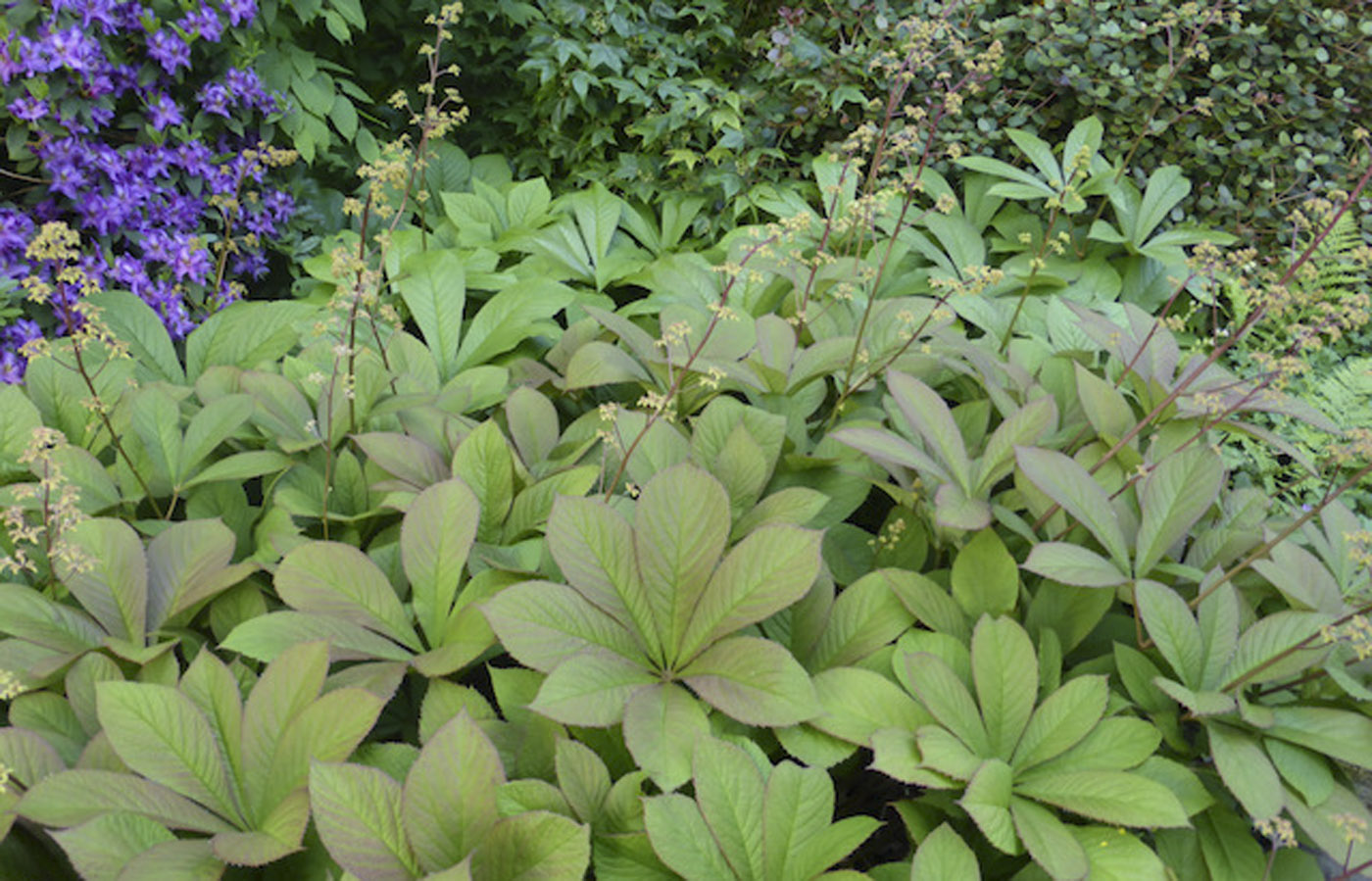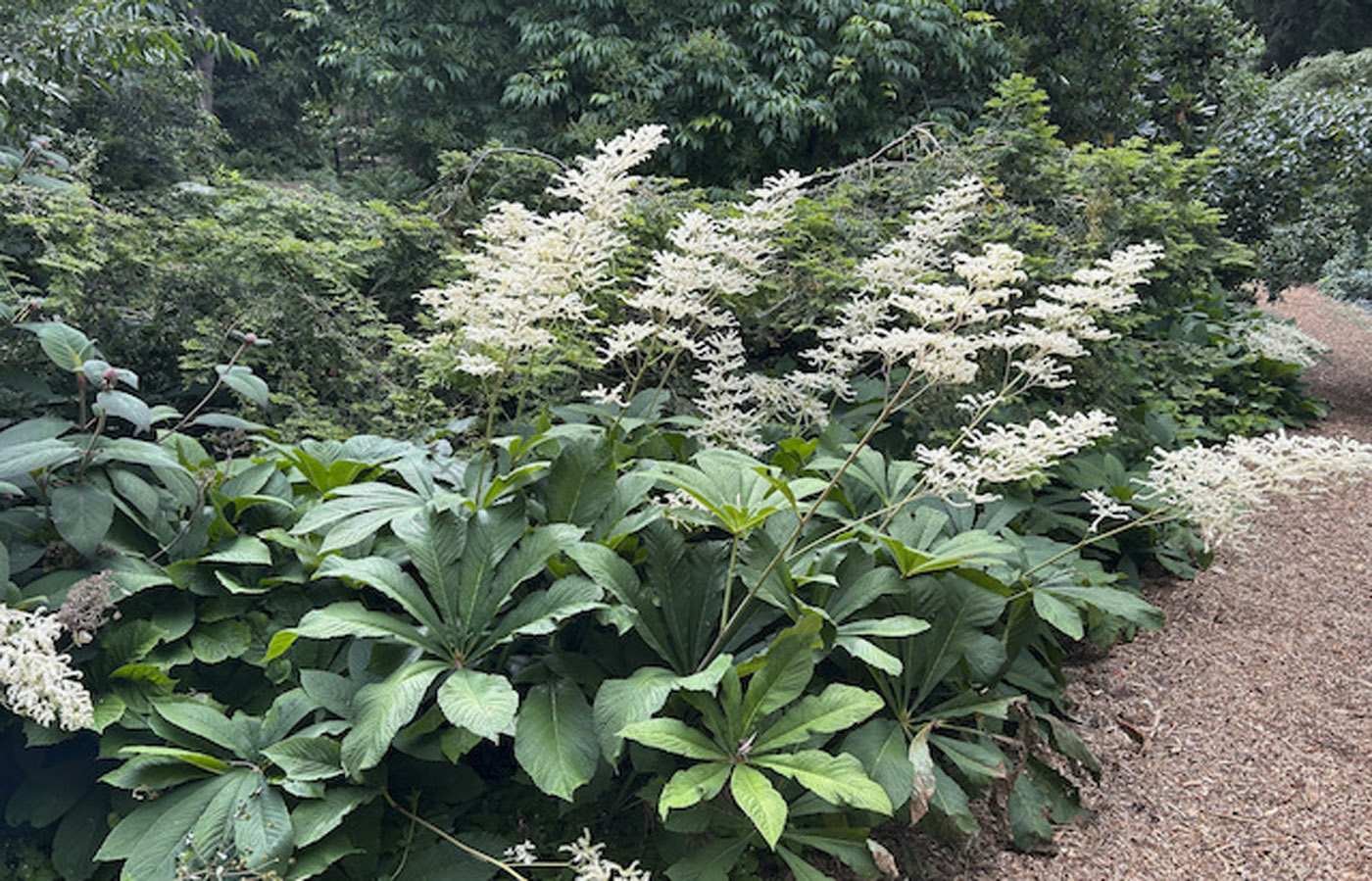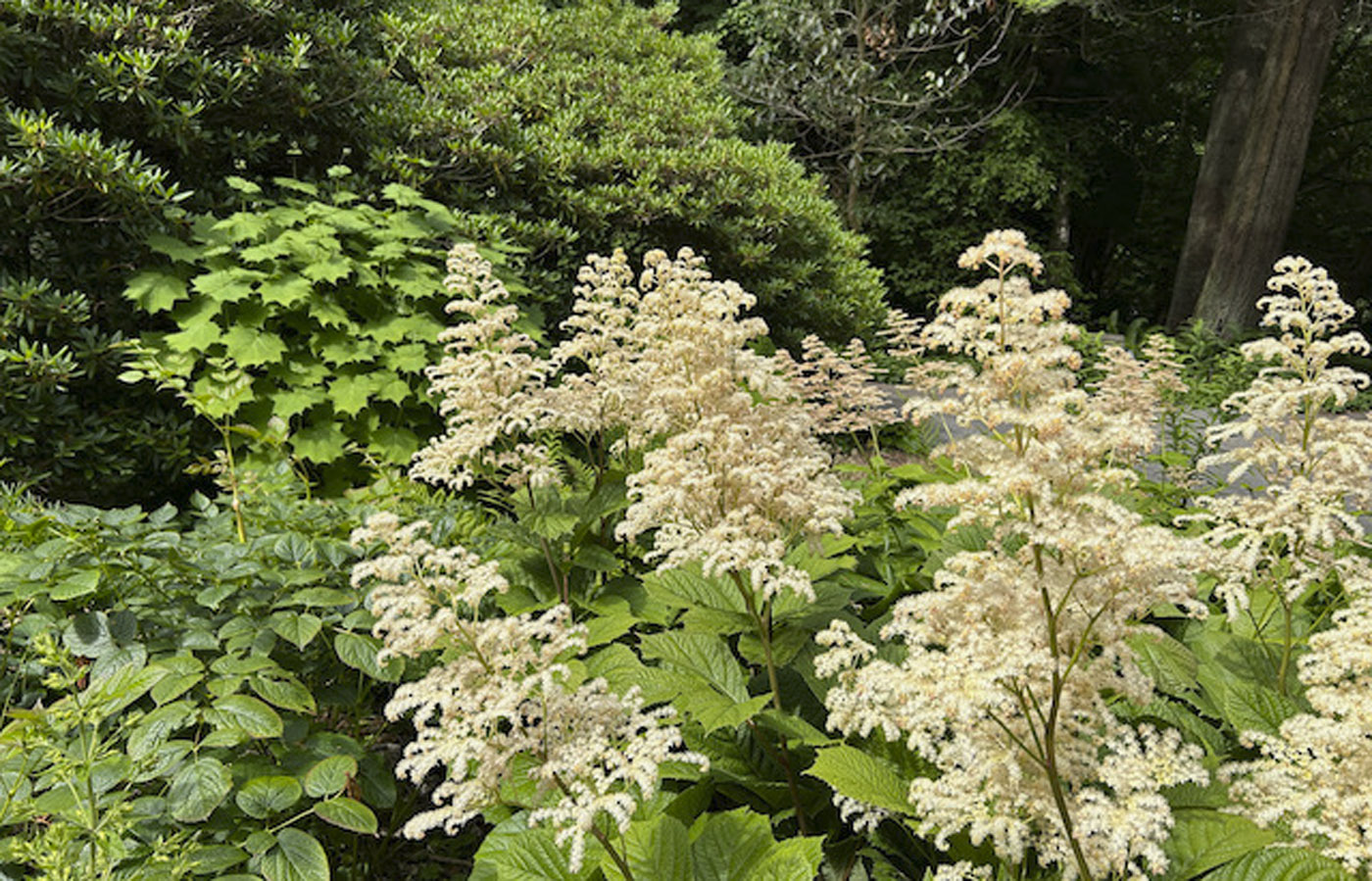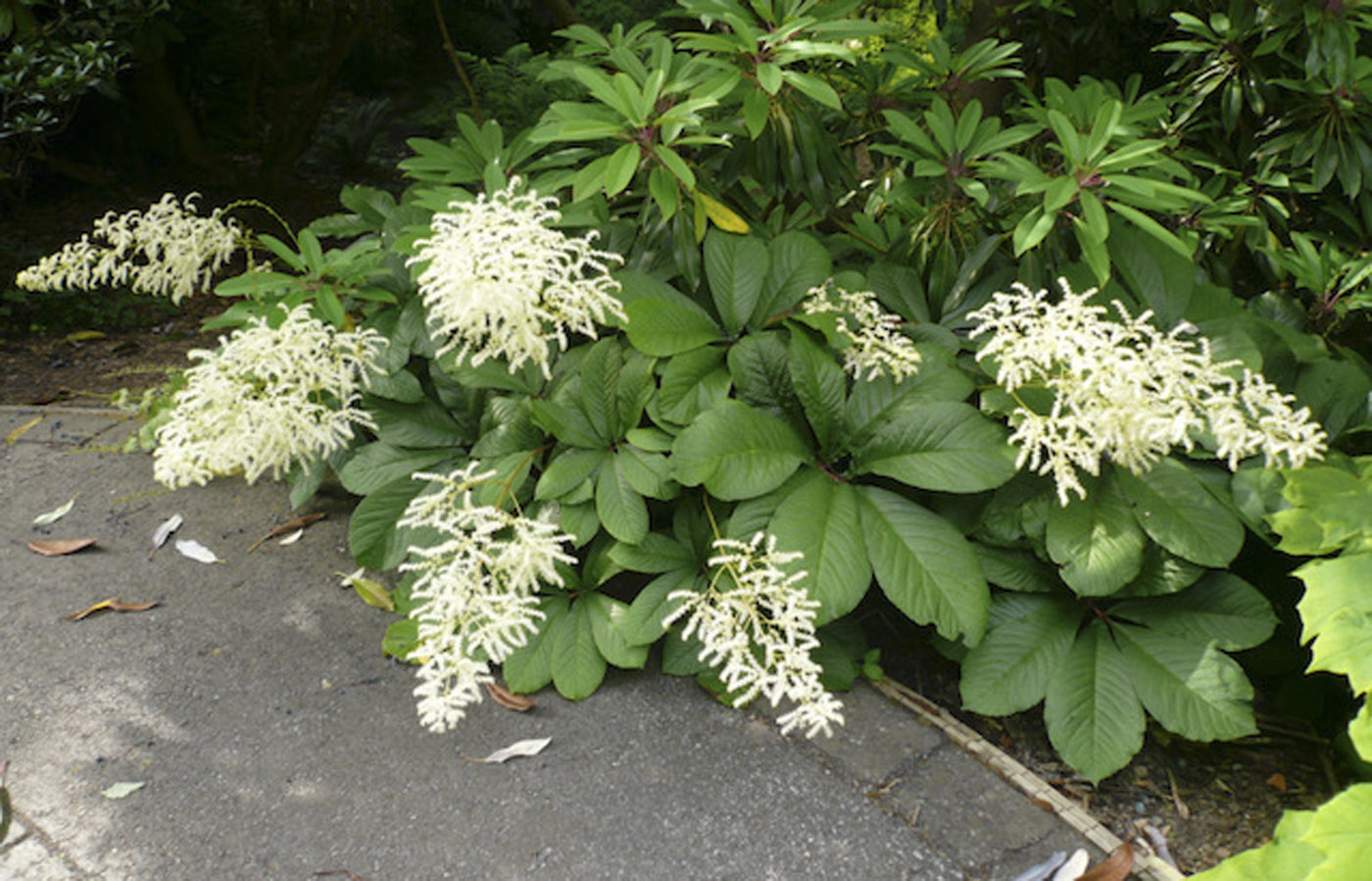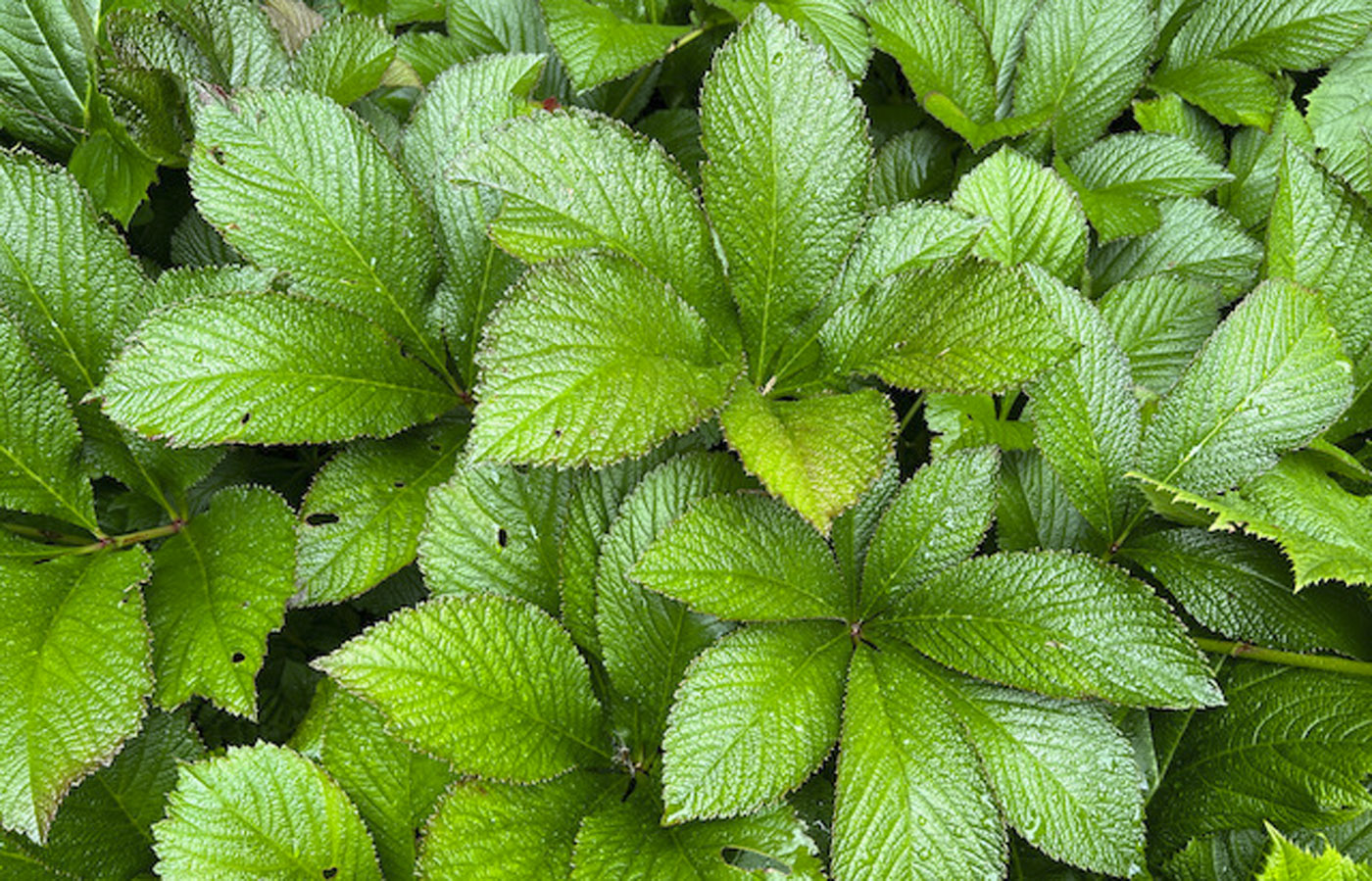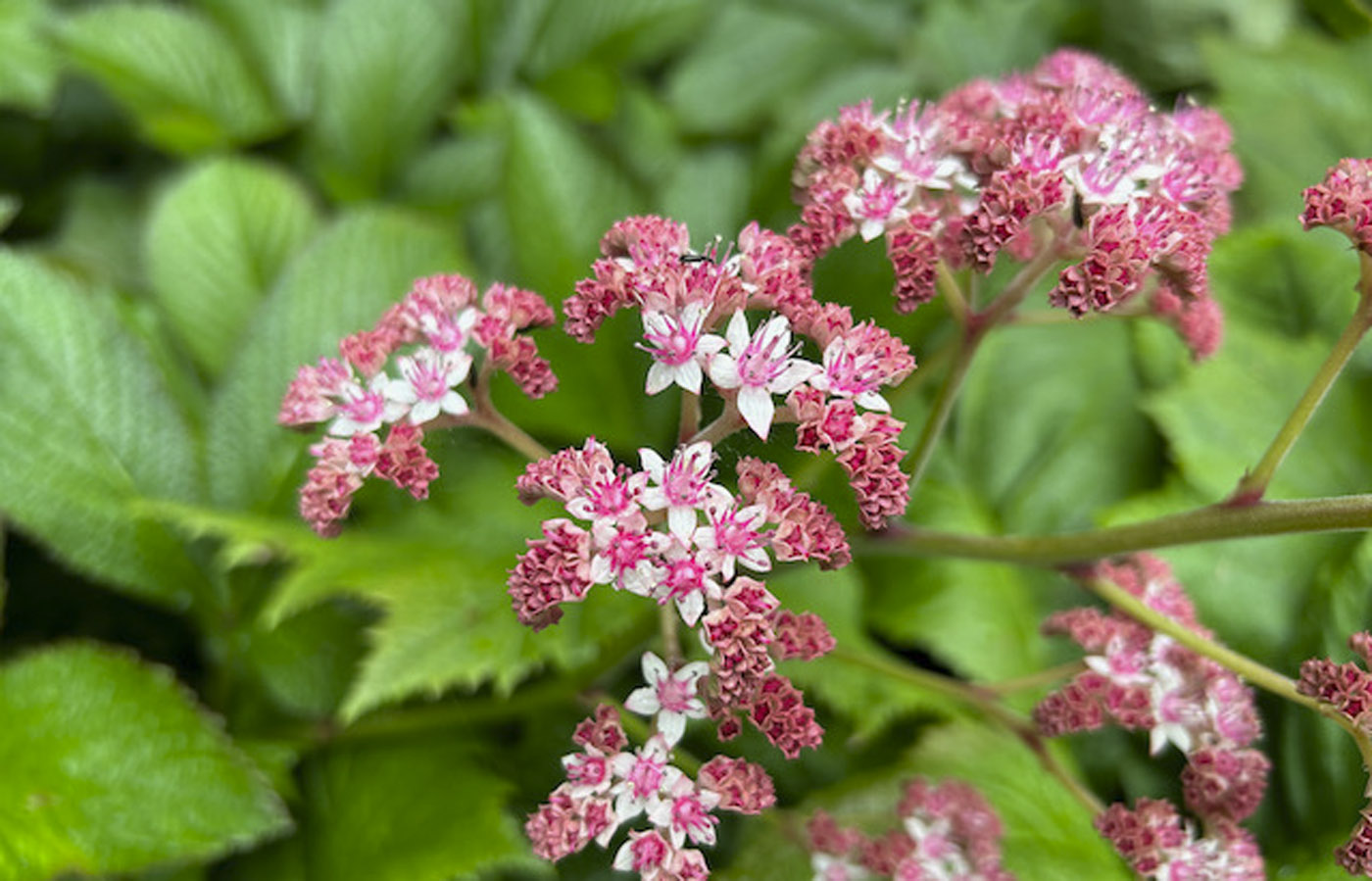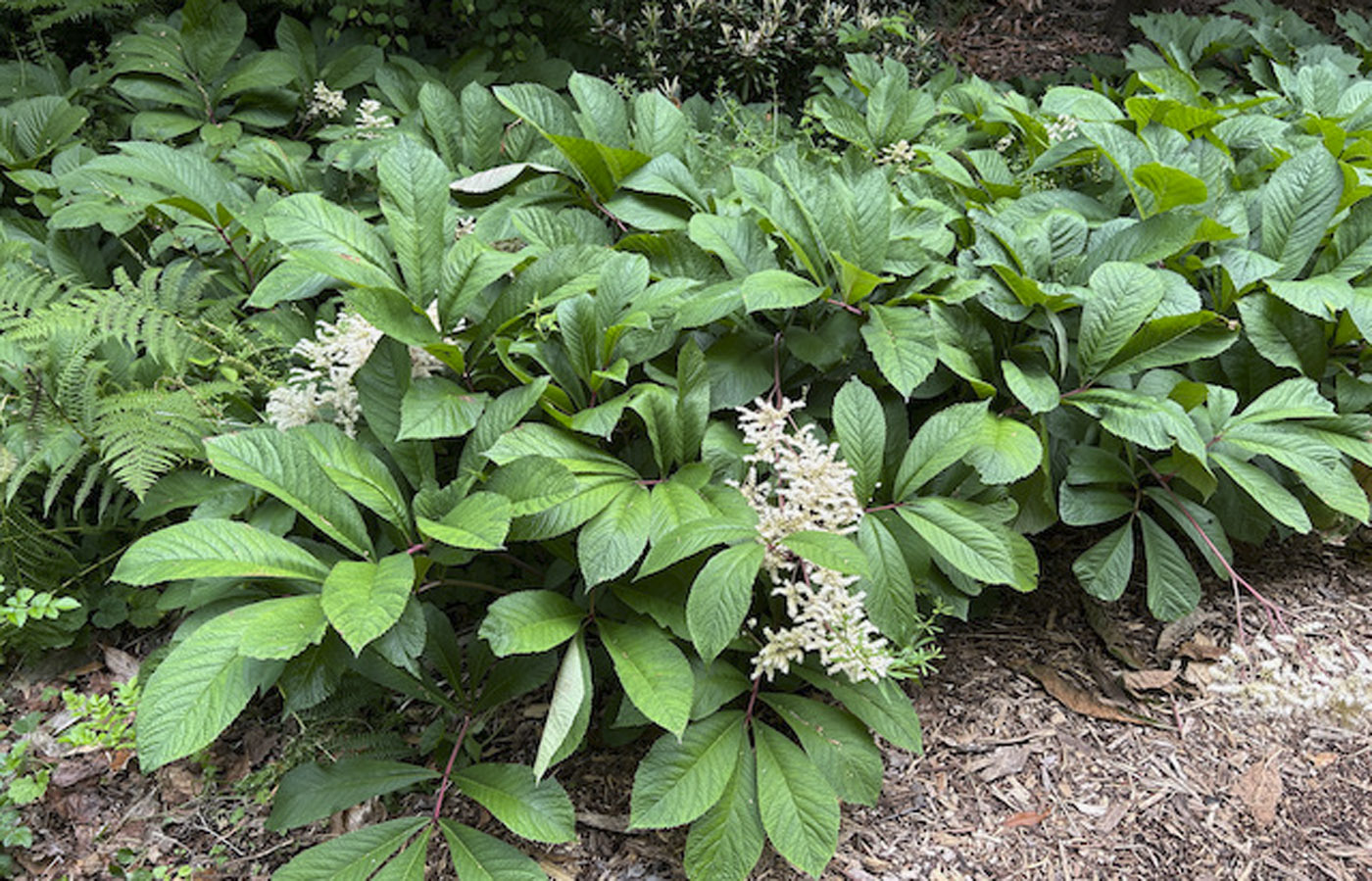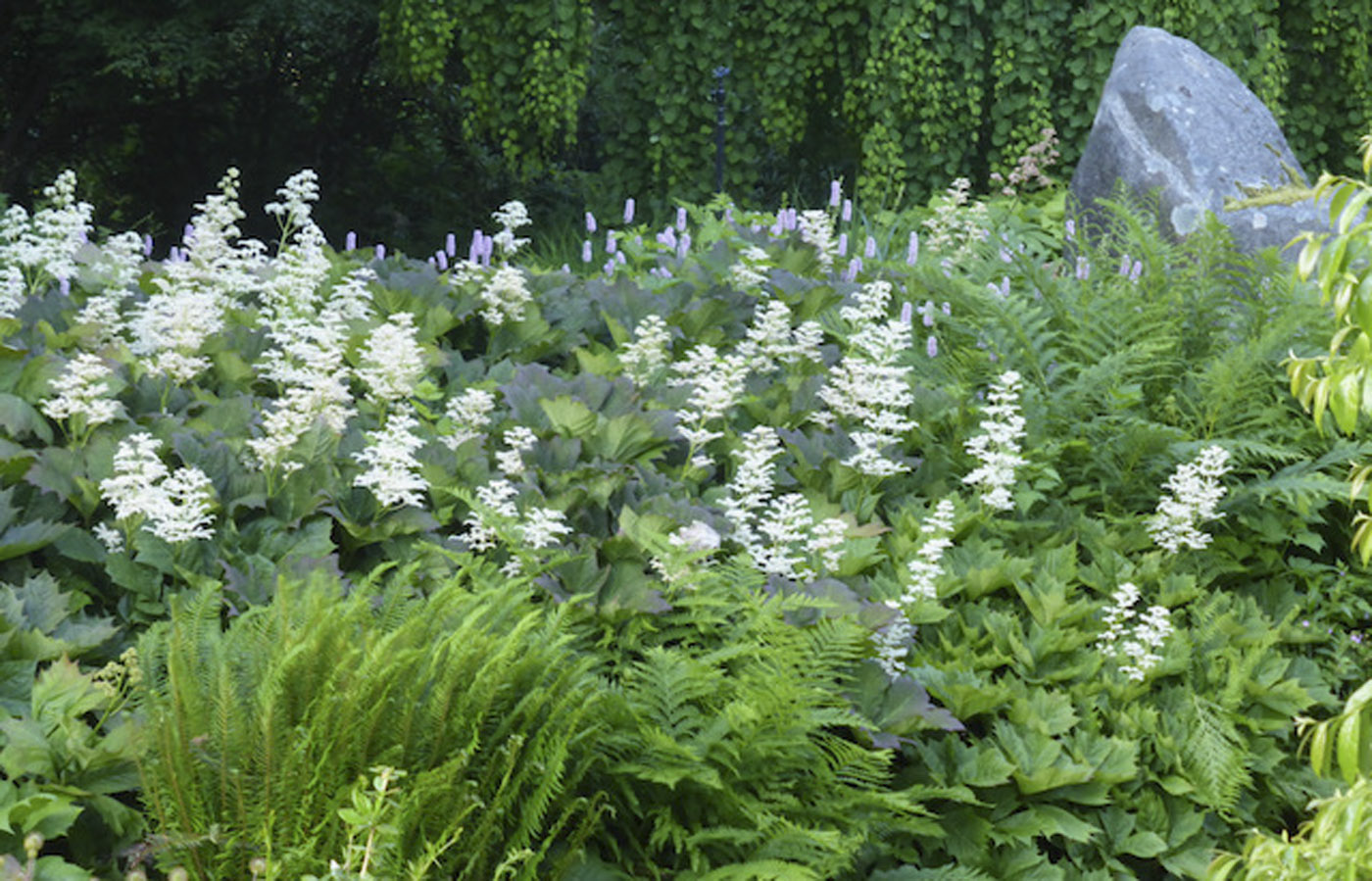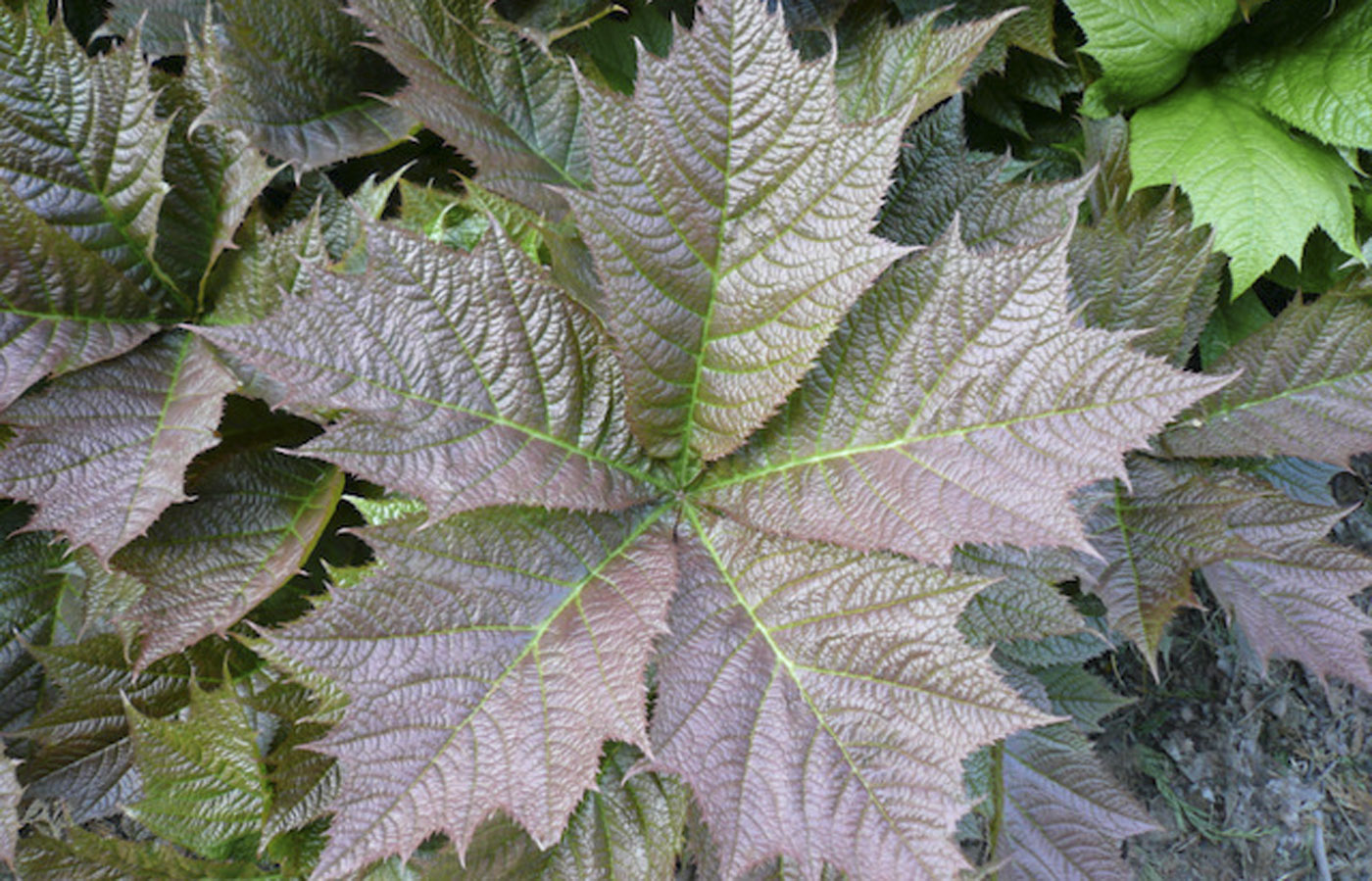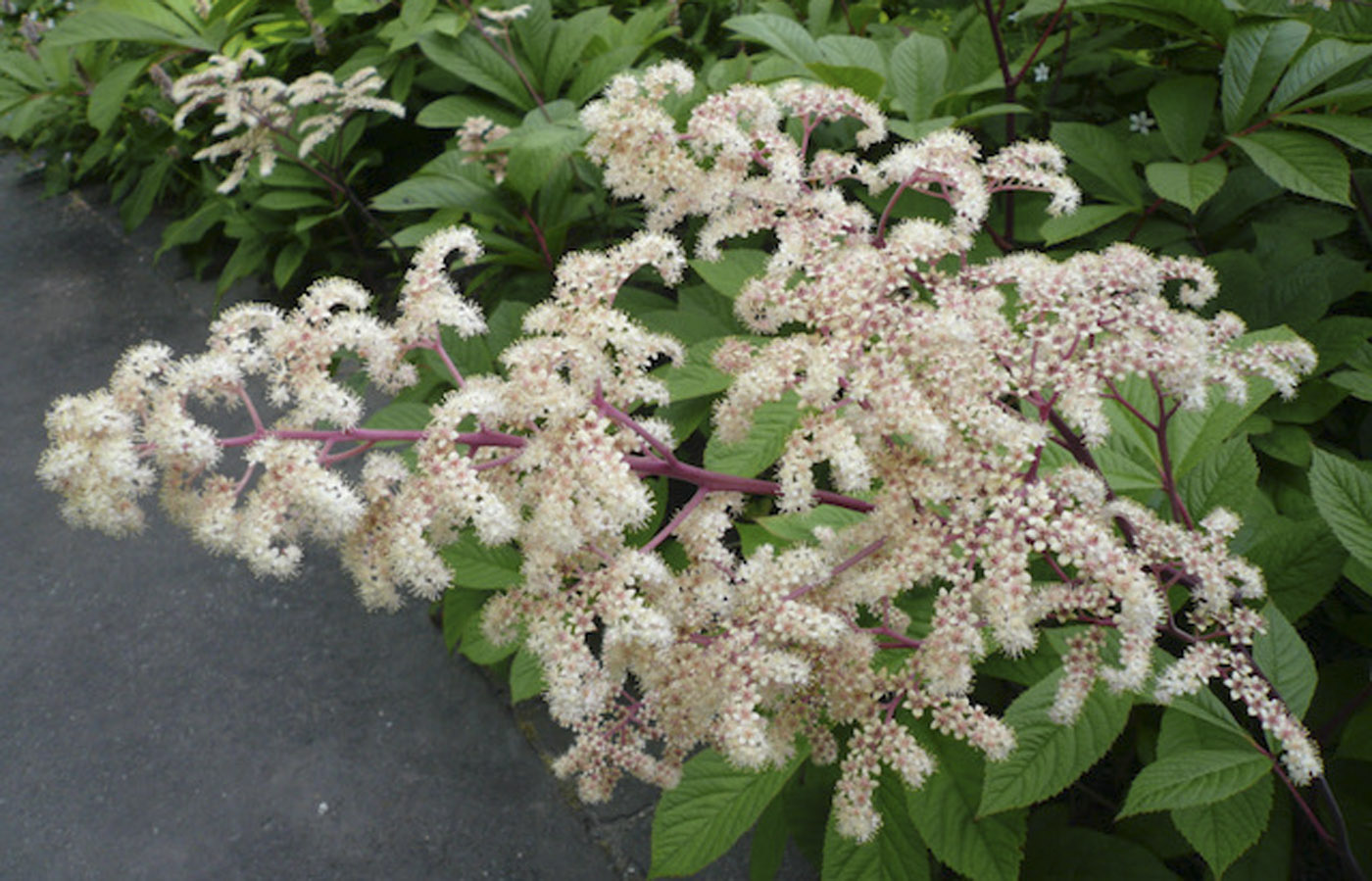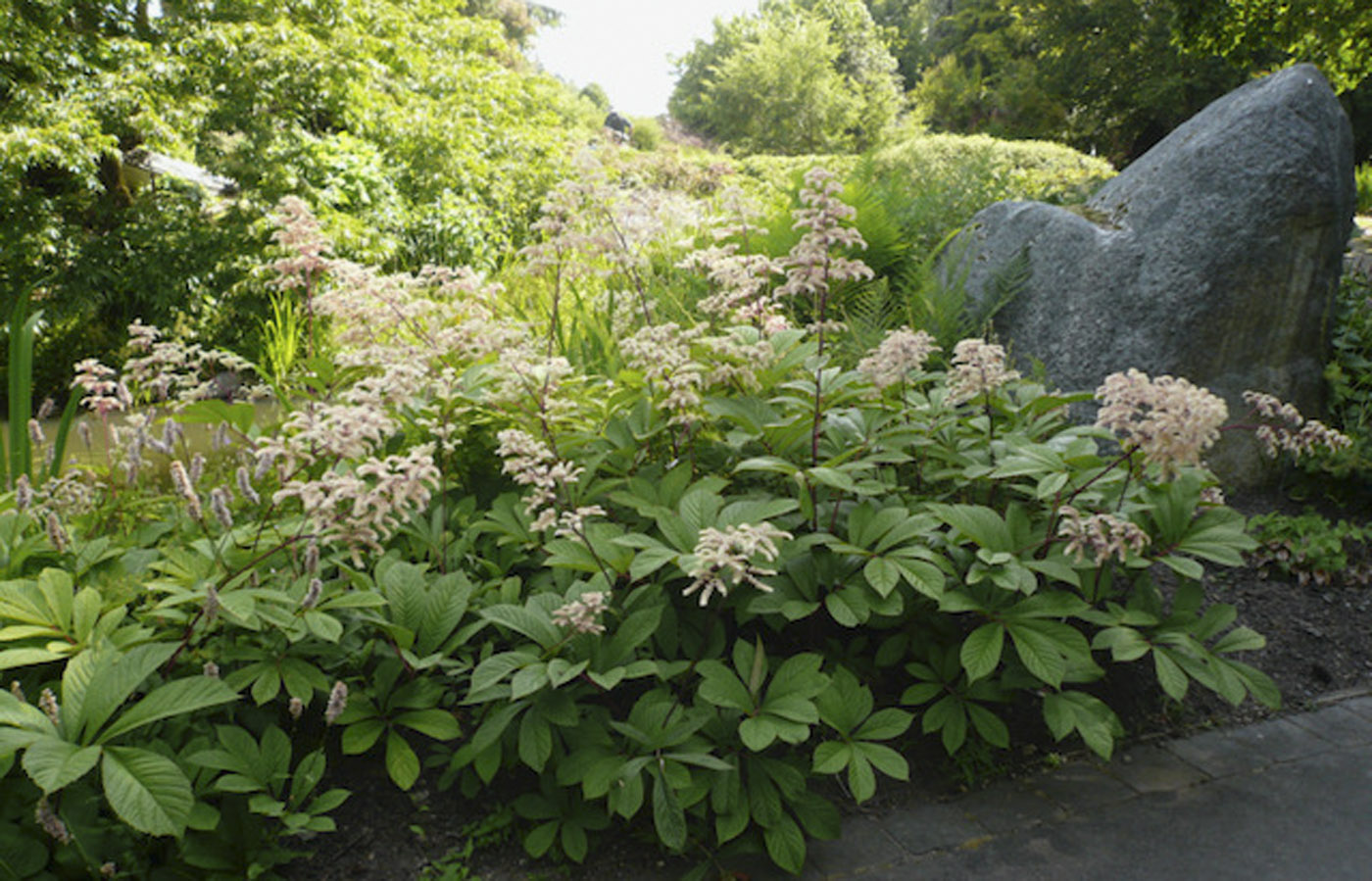
Rodgersia pinnata Superba
July is high season for herbaceous perennials at the Botanical Garden. There are half a dozen areas around the garden where herbaceous displays are prominent, but in terms of sheer real estate, the David C. Lam Asian Garden’s herbaceous collection has the edge. This should not be seen as a popularity contest for perennial plantings in the garden—they are markedly different, and each is exceptional in its own right. They are all worth visiting, especially at this time of year.
Foremost among the summer-blooming herbs in the Asian Garden are the rodgersias. A genus of five herbaceous perennial species native from the Himalayas to East Asia, Rodgersia species are noted for their bold shade-tolerant foliage and large, showy inflorescences (flower stems) composed of small petalless flowers with persistent, coloured sepals—the sepals and stamens taking over the pollinator-attraction duties, as it were. Like the similar, but mostly smaller astilbes, rodgersias are colony-forming, shade-tolerant, summer bloomers that revel in rich, moist soil. Rodgersias are planted throughout the Asian Garden, and because they provide an exceptionally dense canopy of bold, mostly clean, unblemished foliage, they are both texturally beautiful and ideal for suppressing weeds on a large scale. It’s worth mentioning that the “umbrella-leaf rodgersia” (a.k.a. “shieldleaf”), which often accompanies rodgersias in plantings around the Asian Garden, isn’t a rodgersia at all. Astilboides tabularis was once classified as a rodgersia, and the species inhabits the similarly moist habitats in northeast China and Korea, but the two genera are easily distinguished. Astilboides produces huge, umbrella-like leaves and tall, plume-like inflorescences with five-petaled flowers. Look for it on the west side of Upper Asian Way north of Staunton Trail and especially along Stearn Trail.
The robust Rodgersia podophylla (duck-foot rodgersia) covers large areas by means of its rather assertive creeping rhizomes (underground stems). Each wedge-shaped leaflet has three to five jagged drip-tips, the overall appearance resembling (with a little imagination) a duck’s foot. Two distinct colour forms are present in the Asian Garden: bronze-purple and green, though the darker leaves gradually turn green by summer. All forms gradually redden through the heat of summer. Small, star-like white flowers are amply borne on tall, well-branched panicles (a panicle is a branched arrangement of flower stems), and the five sepals, five stamens and central tear-drop-shaped carpel (the carpel contains the ovules, which become the seeds) will age to green or bronze. The species hails from Japan, Korea and adjacent northeast China. While there are numerous plantings, the most prominent are on the east and south sides of the pond near the entrance to the Asian Garden and on the west (lower) side of Wharton Glade.
The similar Rodgersia aesculifolia (finger-leaf rodgersia) has a wide distribution across China. The leaflets are not unlike those of the duck-foot rodgersia, in that they radiate evenly around a central point at the tip of the petiole (leaf stem); however, they have a more quilted texture and serrated margins, rather than lobes at the tips, and look uncannily like those of the horse chestnut tree (Aesculus hippocastanum). The flowers, which can be white or pale pink, are borne on tall, slender panicles. There are plantings along Upper Asian Way on the west side of the path between Staunton Trail and Maries Trail, and a beautiful large patch of mixed seedlings (some bronzy in spring) across the pond from the boardwalk.
Rodgersia pinnata (feather-leaf rodgersia) is a beautiful (some say the most beautiful) species. It has heavily textured leaves that are both palmate in leaflet arrangement (like R. aesculifolia and R. podophylla) and pinnate or feather like. Some botanists describe this as a sub-pinnately compound arrangement. Normally, pinnately compound leaves have leaflets on both sides of a central stalk (a rachis). In R. pinnata, the leaflets can be opposite or alternate along the rachis. There is usually a whorl of three or four leaflets at the base of the rachis and three to five terminal leaflets, as well. The actual leaflet arrangement depends on whether the leaves are basal (i.e., arising directly from the rhizome) or cauline (arising along a stem—in this case, the flower stalk). Most basal leaves are merely palmately compound, looking, for all the world, like the leaves of R. aesculifolia, while others, especially the cauline leaves, are sub-pinnate. In almost all cases, the uppermost cauline leaves have fewer leaflets than the basal leaves. The inflorescences are tall, and open-branched, with white, yellow or rose-pink flowers. There are a number of horticultural selections of R. pinnata, including ‘Superba’, which has leaves that emerge bronze-purple in spring and produce compact panicles of rose-pink flowers. This cultivar holds its leaf colour well into the summer and is renowned for the depth of colour in the aging flowers. Our ‘Superba’ is located behind a large planting of the wild type of R. pinnata in the bed southwest of where Straley Trail crosses Lower Asian Way. There are other large plantings of R. pinnata, including along the east side of Upper Asian Way south of Lam Trail, and on both sides of Upper Asian Way by Staunton Trail. Rodgersia pinnata ‘Elegans’ (on the west side of Upper Asian Way south of Staunton Trail) is noted for its handsomely mounding habit, uniform leaves and creamy-white flowers. A close look at its foliage reveals that palmately compound leaves predominate, suggesting that it might actually be a hybrid with R. aesculifolia.
Rodgersia sambucifolia (elderberry rodgersia) from the mountains of southwestern China, is similar to and often confused with R. pinnata, but is smaller, with flat-topped panicles of white or pink flowers and more strictly (and more obviously) pinnately compound leaves. These have mostly opposite leaflets along the rachis and typically, three terminal leaflets, but no more than a pair of leaves at the base of the rachis. Because of its smaller stature, R. sambucifolia may be overshadowed by the larger, more vigorous rodgersias in some plantings. Look for the elderberry rodgersia north of Straley Trail, west of the pond spur trail, and along the east side of Lower Asian Way between Ludlow Trail and Tschonoski Trail. In the wild, the ranges of R. sambucifolia, R. pinnata and R. aesculifolia overlap, and natural hybrids are known to occur. Some of these hybrids may be represented in the collection, as we have a multitude of plants derived from wild-collected seed from across China. As well, spontaneous garden hybrids—with foliage intermediate between the parent species—are almost certainly lurking in the collection. Admittedly, recognizing the peculiarities and variations in the leaflet arrangements of rodgersias takes some practice, but that should never get in the way of enjoying these attractive plants.
- Astilboides tabularis
- Rodgersia aesculifolia
- Rodgersia aesculifolia
- Rodgersia aesculifolia
- Rodgersia hybrid
- Rodgersia pinnata ‘Elegans’
- Rodgersia pinnata ‘Superba’
- Rodgersia pinnata ‘Superba’
- Rodgersia pinnata
- Rodgersia podophylla
- Rodgersia podophylla
- Rodgersia sambucifolia
- Rodgersia sambucifolia
Submitted by: Douglas Justice, Associate Director, Horticulture and Collections


